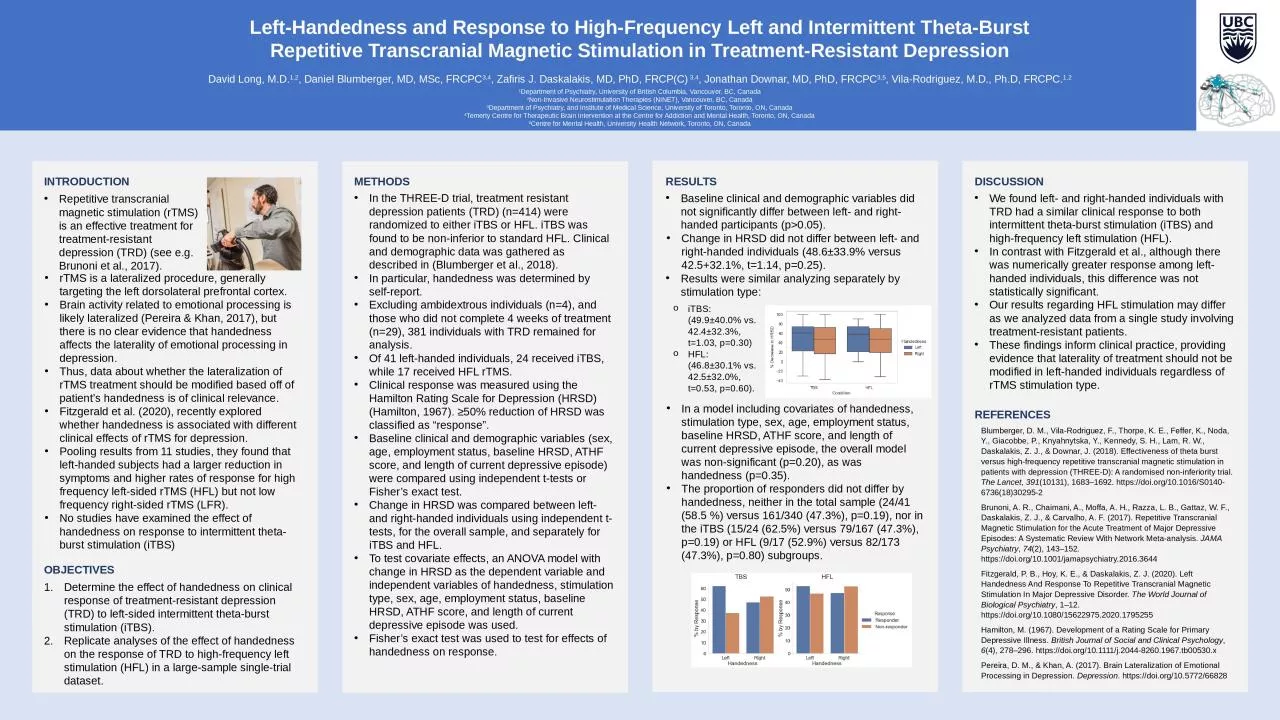

David Long MD 12 Daniel Blumberger MD MSc FRCPC 34 Zafiris J Daskalakis MD PhD FRCPC 34 Jonathan Downar MD PhD FRCPC 35 VilaRodriguez MD PhD FRCPC ID: 927147
Download Presentation The PPT/PDF document "Left-Handedness and Response to High-Fre..." is the property of its rightful owner. Permission is granted to download and print the materials on this web site for personal, non-commercial use only, and to display it on your personal computer provided you do not modify the materials and that you retain all copyright notices contained in the materials. By downloading content from our website, you accept the terms of this agreement.
Slide1
Left-Handedness and Response to High-Frequency Left and Intermittent Theta-Burst Repetitive Transcranial Magnetic Stimulation in Treatment-Resistant Depression
David Long, M.D.
1,2
, Daniel Blumberger, MD, MSc, FRCPC
3,4
,
Zafiris
J. Daskalakis, MD, PhD, FRCP(C) 3,4, Jonathan Downar, MD, PhD, FRCPC3,5, Vila-Rodriguez, M.D., Ph.D, FRCPC.1,2
1Department of Psychiatry, University of British Columbia, Vancouver, BC, Canada2Non-Invasive Neurostimulation Therapies (NINET), Vancouver, BC, Canada3Department of Psychiatry, and Institute of Medical Science, University of Toronto, Toronto, ON, Canada4Temerty Centre for Therapeutic Brain Intervention at the Centre for Addiction and Mental Health, Toronto, ON, Canada5Centre for Mental Health, University Health Network, Toronto, ON, Canada
INTRODUCTION
OBJECTIVES
METHODS
RESULTS
DISCUSSION
REFERENCES
Determine the effect of handedness on clinical response of treatment-resistant depression (TRD) to left-sided intermittent theta-burst stimulation (
iTBS
). Replicate analyses of the effect of handedness on the response of TRD to high-frequency left stimulation (HFL) in a large-sample single-trial dataset.
In the THREE-D trial, treatment resistant depression patients (TRD) (n=414) were randomized to either iTBS or HFL. iTBS was found to be non-inferior to standard HFL. Clinical and demographic data was gathered as described in (Blumberger et al., 2018). In particular, handedness was determined by self-report. Excluding ambidextrous individuals (n=4), and those who did not complete 4 weeks of treatment (n=29), 381 individuals with TRD remained for analysis. Of 41 left-handed individuals, 24 received iTBS, while 17 received HFL rTMS. Clinical response was measured using the Hamilton Rating Scale for Depression (HRSD) (Hamilton, 1967). ≥50% reduction of HRSD was classified as “response”. Baseline clinical and demographic variables (sex, age, employment status, baseline HRSD, ATHF score, and length of current depressive episode) were compared using independent t-tests or Fisher’s exact test. Change in HRSD was compared between left- and right-handed individuals using independent t-tests, for the overall sample, and separately for iTBS and HFL. To test covariate effects, an ANOVA model with change in HRSD as the dependent variable and independent variables of handedness, stimulation type, sex, age, employment status, baseline HRSD, ATHF score, and length of current depressive episode was used. Fisher’s exact test was used to test for effects of handedness on response.
Baseline clinical and demographic variables did not significantly differ between left- and right-handed participants (p>0.05).
We found left- and right-handed individuals with TRD had a similar clinical response to both intermittent theta-burst stimulation (iTBS) and high-frequency left stimulation (HFL). In contrast with Fitzgerald et al., although there was numerically greater response among left-handed individuals, this difference was not statistically significant. Our results regarding HFL stimulation may differ as we analyzed data from a single study involving treatment-resistant patients. These findings inform clinical practice, providing evidence that laterality of treatment should not be modified in left-handed individuals regardless of rTMS stimulation type.
Blumberger, D. M., Vila-Rodriguez, F., Thorpe, K. E., Feffer, K., Noda, Y., Giacobbe, P., Knyahnytska, Y., Kennedy, S. H., Lam, R. W., Daskalakis, Z. J., & Downar, J. (2018). Effectiveness of theta burst versus high-frequency repetitive transcranial magnetic stimulation in patients with depression (THREE-D): A randomised non-inferiority trial. The Lancet, 391(10131), 1683–1692. https://doi.org/10.1016/S0140-6736(18)30295-2Brunoni, A. R., Chaimani, A., Moffa, A. H., Razza, L. B., Gattaz, W. F., Daskalakis, Z. J., & Carvalho, A. F. (2017). Repetitive Transcranial Magnetic Stimulation for the Acute Treatment of Major Depressive Episodes: A Systematic Review With Network Meta-analysis. JAMA Psychiatry, 74(2), 143–152. https://doi.org/10.1001/jamapsychiatry.2016.3644Fitzgerald, P. B., Hoy, K. E., & Daskalakis, Z. J. (2020). Left Handedness And Response To Repetitive Transcranial Magnetic Stimulation In Major Depressive Disorder. The World Journal of Biological Psychiatry, 1–12. https://doi.org/10.1080/15622975.2020.1795255Hamilton, M. (1967). Development of a Rating Scale for Primary Depressive Illness. British Journal of Social and Clinical Psychology, 6(4), 278–296. https://doi.org/10.1111/j.2044-8260.1967.tb00530.xPereira, D. M., & Khan, A. (2017). Brain Lateralization of Emotional Processing in Depression. Depression. https://doi.org/10.5772/66828
Repetitive transcranial magnetic stimulation (rTMS) is an effective treatment for treatment-resistant depression (TRD) (see e.g. Brunoni et al., 2017).
In a model including covariates of handedness, stimulation type, sex, age, employment status, baseline HRSD, ATHF score, and length of current depressive episode, the overall model was non-significant (p=0.20), as was handedness (p=0.35). The proportion of responders did not differ by handedness, neither in the total sample (24/41 (58.5 %) versus 161/340 (47.3%), p=0.19), nor in the iTBS (15/24 (62.5%) versus 79/167 (47.3%), p=0.19) or HFL (9/17 (52.9%) versus 82/173 (47.3%), p=0.80) subgroups.
Results were similar analyzing separately by stimulation type:
Change in HRSD did not differ between left- and right-handed individuals (48.6±33.9% versus 42.5+32.1%, t=1.14, p=0.25).
iTBS: (49.9±40.0% vs. 42.4±32.3%, t=1.03, p=0.30) HFL: (46.8±30.1% vs. 42.5±32.0%, t=0.53, p=0.60).
rTMS
is a lateralized procedure, generally targeting the left dorsolateral prefrontal cortex.
Brain activity related to emotional processing is likely lateralized (Pereira & Khan, 2017), but there is no clear evidence that handedness affects the laterality of emotional processing in depression.
Thus, data about whether the lateralization of
rTMS
treatment should be modified based off of patient’s handedness is of clinical relevance.
Fitzgerald et al. (2020), recently explored whether handedness is associated with different clinical effects of
rTMS for depression. Pooling results from 11 studies, they found that left-handed subjects had a larger reduction in symptoms and higher rates of response for high frequency left-sided rTMS (HFL) but not low frequency right-sided rTMS (LFR). No studies have examined the effect of handedness on response to intermittent theta-burst stimulation (iTBS)